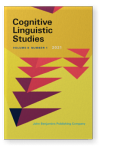Vol. 8:1 (2021) ► pp.204–233
Eating we live by
eating metaphors in Mandarin Chinese
eating plays a pivotal role in Chinese culture as echoed in the saying mín yǐ shí wéi tiān “Eating is everything for people”. In Chinese, a multitude of expressions related to eating are metaphorically used to talk about aspects of living and we call them “eating metaphors”. eating metaphors are largely motivated by the primary metaphor living is eating. This paper focuses on three prominent elements of the eating activity (i.e., living as “a process of eating”, living as “a kind of food” and living as “a tool for eating or cooking”) which give rise to the following metaphors: social activity is a process of eating, mental activity is a process of eating, social activity is food, mental activity is taste of food, humans are food, social activity is a tool for eating/cooking, and mental activity is attribute of tools for eating/cooking. The mappings from the domain of eating to the domain of living are largely based on their similarities on the generic level. Using the apparatus of clics 3, we find that the concept of eat in Chinese can colexify drink, intake, chew, learn, consider, understand, invade, possess, deprive, absorb, coitus, depend, and consume, and all cases of colexification can be accounted for by the living is eating metaphor. It is the experiential similarities between the living activity and the eating activity that make the structural mappings between two domains possible and that people can use one domain of experience to talk about another.
Article outline
- 1.Introduction
- 2.The structural mappings in eating metaphors
- 3.The systematic correspondences between two domains in eating metaphors
- 3.1Living as “a process of eating”
- 3.2Living as “a kind of food”
- 3.3Living as “a tool for eating or cooking”
- 4. eating metaphors and colexification of chī “eat”
- 5.Conclusion
- Acknowledgements
- Note
- The following abbreviations are used in this paper
-
References
